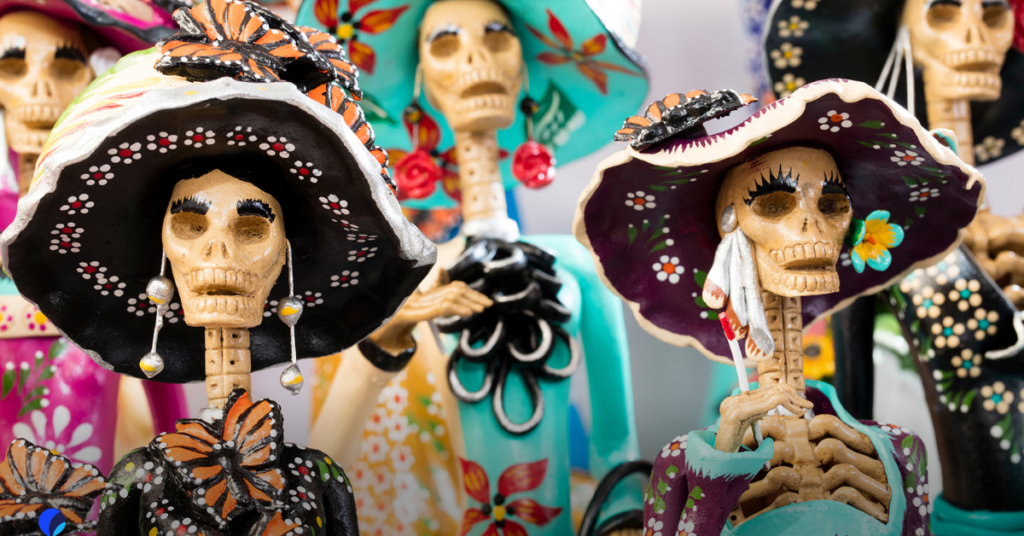
Celebrate Día De Los Muertos – with Sugar Skulls and Day of the Dead Movies
They are sweet, colorful, and one of the most iconic symbols of Día De Los Muertos. We are talking about las dulces calaveras (“sugar skulls”), a fundamental part of this traditional Mexican holiday.
Made of sugar, water, and lemon, las calaveras can pay homage to loved ones that have passed away.
Always brightly decorated, you’ll find these sugar skulls everywhere during Día De Los Muertos festivities. They’ve become so popular, you’ll even see them in other places around the world, such as during Halloween in the United States.
Wondering where they come from? Here’s your look into the history of the Day of the Dead Sugar Skulls.
What Are Calaveras?
When we say “calavera” we’re usually talking about the brightly colored and ornate skulls that are ubiquitous in the Día de los Muertos celebrations. The term means “skull” in Spanish, but it doesn’t have a macabre connotation like in English. You’ll also see these referred to as calaveritas, which is the diminutive of calaveras.
In addition to the colorful skulls, “calaveras” can refer to a poem written and published around the Day of the Dead. These are traditionally short and witty poems and are often humorous.
But we’re focusing on the skulls. On the Day of the Dead, you’ll see calaveras everywhere: in candied sweets, on parade masks, painted on the faces of dolls, or even on people’s faces!
The History of The Day of the Dead Sugar Skulls – Where do Calaveras Come From?
The sugar skull tradition can be traced back over 3,000 years ago.
Before contact with Europe, mesoamerican civilizations commonly used the representations of the skulls in cultural activities. For example, some civilizations commonly displayed a tzompantli, a rack used to mount the skulls of human sacrifices or prisoners of war. These were used to present offerings to the underworld god, Mictlantecuhtli.
The belief in life after death was very strong in these cultures, and they saw this display of skulls as a way to help individuals make a safe passage to the underworld.
The arrival of the Spanish conquistadors and Christianity resulted in a partial loss of these traditions.
However, the importance of the skull has been retained to this day. It continues to represent a desire for deceased people to have a safe passage to the underworld.
Why are Calaveras Made Out of Sugar?
Historians believe that the Catholic friars who arrived in the Americas with the Spanish brought with them knowledge of how to make decorations with sugar. These methods became popular in Mexico partly because sugar was plentiful: a cheap and easily accessible material.
With clay molds, it became easy and inexpensive to make many calaveras, which were then used to decorate the tombstones, churches, and ofrendas (objects placed on the altar for the festivities) during the Day of the Dead celebrations.
While calaveras are usually made out of sugar, most aren’t for eating.
La Calavera Catrina
The best-known calavera is La Calavera Catrina, which appeared in Mexican culture thanks to the work of José Guadalupe Posada.
Posada was an artist and a printmaker. He first created Calavera Catrina as a zinc etching around 1910. Catrina was a skeleton in a large, fancy hat made to look similar to hats that were common in Europe around that time. The work is thought to be a satire of Mexican women who deny their indigenous heritage by adopting European traditions.
It may also be a political satire piece criticizing the Dictator Porfirio Díaz, Mexico’s president until 1911. Díaz was supposed to have been obsessed with European culture and with materialism.

While Posada created Catrina in 1910, the work achieved a new level of fame when it was recreated by the prolific Mexican artist Diego Rivera in his mural Sueño de una Tarde Dominical en la Alameda Central (“Dream of a Sunday afternoon along Central Alameda”).
These days, Calavera Catrina, often just called “Catrina” or “La Catrina,” is a very popular character in the Day of the Dead celebrations and as a Halloween costume in the United States.

What is the Day of the Dead?
The sugar skulls are a fundamental part of the decoration and festivity of The Day of the Dead, a celebration that honors the lives of loved ones who have passed away. It is a beautiful way to share memories, celebrate life, and cope with the pain of longing for friends and family.
Historically, the ancient Mesoamerican civilization had a month-long celebration to honor the dead in the summer. However, with Spanish colonization and the spread of Christianity, the celebration increasingly became associated with the Christian celebrations of All Saint’s Eve (Halloween), All Saint’s Day, and All Souls Day every year from October 31st to November 2nd.
More recently, traditional belief has held that the gates of heaven open every year at the end of October 31. On November 1, the spirits of deceased children are believed to be able to join their families for one day on the Dia de los Angelitos (Day of the Little Angels).
On November 2, Día de Los Defuntos (Day of the Deceased), the spirits of adults are honored and are believed to be able to join their families for celebration.
This beautiful celebration of life and death combines indigenous rituals of ancient civilizations with the spiritual practices of Catholicism.
Día De Los Muertos Decorations and Meaning
During the festivities, family members make altars (ofrendas) to honor loved ones, with photos of the deceased, food and drinks they used to like, and even old pieces of clothing. The sugar skulls are put on the altars to highlight the tributes with their vibrant colors.
On November 1, smaller sugar skulls are placed on the altars in honor of children. They are replaced with larger ones the next day to honor adults.
The skulls are often decorated with stripes, dots, swirls, and colored leaves, beads, or sequins. Some use luminous paint that glows in the dark.
Why Do Some Sugar Skulls Have Names Written on Them?
During the festivities, giving your friends and family—even those still living—a sugar skull with their name on it is common. This is a way of showing appreciation and affection for someone.
Giving a sugar skull as a gift also represents a desire for the person to have a special place reserved for them in the underworld after they have passed away.
So don’t be scared if you win a sugar skull during the Day of the Dead. It’s just someone expressing their affection for you.
How are Calaveras Made?
Anyone can make sugar skulls—they’re easy and are a great addition to any Day of the Dead celebration.
They are made with a mixture called alfeñique consisting of sugar, hot water, and lemon. This mixture creates a caramel-like dough, which can be molded into a skull.
Once dried, you can decorate your calavera with paint, beads, feathers, painted leaves, etc. Sugar skulls are decorated with almonds, honey, and even gum in some places in Mexico.
Make Your Own Calavera Recipe
If you want to make one at home, try this Calavera recipe.
You can also buy calaveras in different sizes, colors, and types online.
The Best Must-Watch Day of the Dead Movies
If you’ve never seen Día de los Muertos celebrations yourself, you might be able to get a sense of the experience through movies. Here are 4 movies that are wonderful on their own but can also give you a sense of the history of the Day of the Dead sugar skulls and how the holiday is celebrated.
(If you’re learning Spanish, try watching them in that language as part of your home language learning program!)
Coco
Winner of the Oscar for the best-animated feature at the 90th Academy Awards, Coco is a beautiful story about memory, dreams, love, and forgiveness throughout several generations of the same family. It takes place during the Day of the Dead celebrations.
James Bond’s Spectre
Although not focused entirely on Day of the Dead festivities, James Bond’s Spectre features an opening scene that purportedly takes place in Mexico during a Day of the Dead parade. As a matter of fact, it was this movie that prompted Mexico to begin a Day of the Dead parade!
The Book of Life
The movie tells the story of Manolo, a young man who must choose between fulfilling his family’s expectations and following his heart. The story gives a sense of the beliefs about the underworld and the importance of remembering those who have passed away.
Macario
The famous horror film of the 1960s tells the story of a hungry peasant, Macario, who wishes for a good meal on the Day of the Dead. The spooky film covers several Day of the Dead themes, including the importance of the afterlife.
Celebrate Día De Los Muertos – the Mexican Day of the Dead with Free Zoom Backgrounds and Spanish Lessons!

Take your Spanish language skills to the next level. Pimsleur lessons stream directly to your home and are easily accessed through your device of choice — mobile phone, computer, tablet, or Amazon Echo devices. Learn on your own or with up to 4 family members for the same price. Gain real-world conversational skills in the comfort of your home or anywhere life takes you in the future.
Try a FREE LESSON today!

Have you ever attended a Day of the Dead parade or made a sugar skull to honor loved ones? Share your experience in the comments.
1 Comment for "Day of the Dead Sugar Skulls – Creepy Calaveritas!"